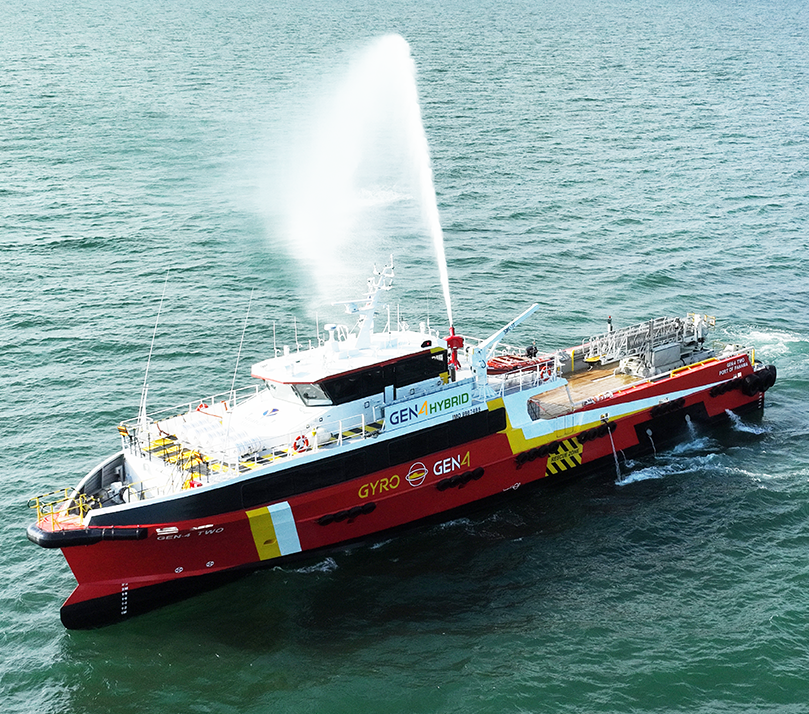AWARDS 2023 | BEST W2W CRAFT – GEN-4 TWO – STRATEGIC MARINE & SOUTHERLY DESIGNS

The long-standing and very productive collaboration of Western Australia’s renowned naval architects, Southerly Designs and leading Singaporean shipbuilder, Strategic Marine, has created yet another elegant, efficient, safe, fast and comfortable crew-supply boat for the global offshore energy industry.
Significantly refined over previous iterations, this 42-metre aluminium boat is also capable of effectively performing firefighting and standby roles. The W2W facility on its aft deck is simply the cream on its cake.

“It is the first fast crewboat supporting the oil and gas industry that incorporates a gyro-stabiliser, a motion compensated gangway, and a hybrid system,” Hans Randklev, General Manager – Commercial at Strategic Marine, told Baird Maritime. “It also features enhancements to the hull design to enable it to be more efficient during transit and incorporates modern interiors with the oil rig crew’s comfort and safety in mind.”
Randklev added that, based on the crewboat’s performance to date, it can be seen that it has a wider operating window, a faster turnaround, a higher speed, improved comfort and safety, as well as lower fuel consumption and emissions compared to other fast crewboats of similar size. This results in fewer cancelled trips as well as lower costs and emissions.
“The vessel serves as a demonstrator platform and proof of concept for many new systems that have not been a part of the traditional workboat outfit,” added Southerly Designs Managing Director Andrew Taylor. “Among these are active interceptor ride control and trim optimisation and an integrated joystick control positioning and manoeuvring system.”

Randklev remarked that construction did not present any difficulty, and that Strategic Marine gained a better appreciation of the benefits of marginal gains in shipbuilding.
“After performing a full review of the vessel’s hull shape, appendages, propulsors, shafts, structure, weights, etc, we managed to improve performance quite significantly compared with the previous generation of vessels while using the same power.”
For Taylor, there is a constant need to update and evolve to meet new demands emanating from multiple sources such as new contractual requirements initiated by the end users, a focus on passenger and crew comfort, integration of new technologies, environment and emissions standards, and cost and fuel consumption requirements to name a few.
“The requirements and expectations of vessel owners and their clients are not static and we must be prepared to find the solution to facilitate them with each new vessel being designed and constructed.”
Taylor said Southerly Designs enjoyed a highly productive year in 2023. The company has 30 vessels under contract and in every stage of design and construction from preliminary development through to final sea trials.
“Things are shaping up to continue along the same track for 2024,” he told Baird Maritime, “and we are currently working on increasing our manpower to meet the demands of current and upcoming contracts. The future remains bright and we are optimistic, as we are seeing strong demand across sectors such as offshore crewboats, sea rescue, pilot boats, and luxury craft.”
The previous year was also fruitful for Strategic Marine.
“Our yard has been working at capacity with plenty of exciting projects underway for customers across three continents,” explained Randklev. “The offshore energy sector is particularly active for us at the moment, and I believe it is a direct reflection of the significant development work and investments we have made over the last couple of years to bring out new and highly evolved vessel solutions for the offshore wind and offshore oil and gas markets.”
He added that Strategic Marine is also seeing healthy interest developing in the market for fast ferries, and this has raised expectations that the company’s orderbook will be including several of these vessels going forward.
“The future looks bright for Strategic Marine and 2024 is shaping up to be another good year,” said Randklev.”Being in Singapore, we also see emphasis to meet GHG goals set for 2030 towards 2050. The associations related to the industries are proactively assisting local companies transit towards the same path, and so we will adapt to allow for progressive changes to these trends in the coming years.”
This post was originally published by BAIRD MARITIME and can be found at their website www.bairdmaritime.com
